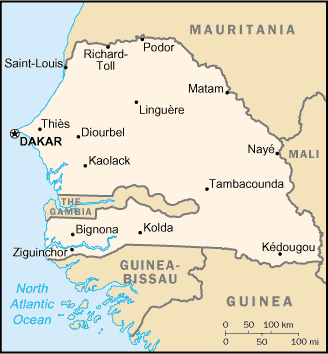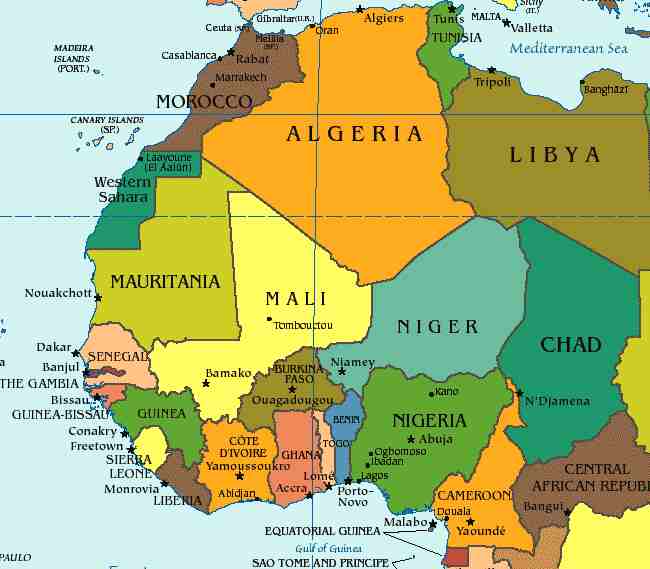|
SENEGAL
Please use our A to Z INDEX to navigate this site
|
|||||
|
Senegal (French: le Sénégal), officially the Republic of Senegal, is a country south of the Sénégal River in western Africa. Senegal is bounded by the Atlantic Ocean to the west, Mauritania to the north, Mali to the east, and Guinea and Guinea-Bissau to the south. The Gambia lies almost entirely within Senegal, surrounded on the north, east and south; from its western coast, The Gambia's territory follows the Gambia River more than 300 kilometers (186 mi) inland.
The Cape Verde islands lie some 560 kilometers (348 mi) off the Senegalese coast, but Cap Vert is a peninsula near Senegal's capital Dakar, and the western-most point in Africa.
Senegal W. Africa
History
Archaeological findings throughout the area indicate that Senegal was inhabited in prehistoric times. Since then, Senegal has had a varied cultural history of kingdoms, brotherhoods and colonial struggles (between and against colonizing powers).
Eastern Senegal was once part of the Empire of Ghana. It was founded by the Tukulor in the middle valley of the Senegal River. Islam, the dominant religion in Senegal, first came to the region in the 11th century. In the 13th and 14th centuries, the area came under the influence of the Mandingo empires to the east; the Jolof Empire of Senegal also was founded during this time.
Various European powers - Portugal, the Netherlands, and England - competed for trade in the area from the 15th century onward, until in 1677, France ended up in possession of what had become an important slave trade departure point - the infamous island of Gorée next to modern Dakar. It was only in the 1850s that the French began to expand their foothold onto the Senegalese mainland, at the expense of native kingdoms such as Waalo, Cayor, Baol, and Jolof.
In January 1959, Senegal and the French Sudan merged to form the Mali Federation, which became fully independent on June 20, 1960, as a result of the independence and the transfer of power agreement signed with France on April 4, 1960. Due to internal political difficulties, the Federation broke up on August 20. Senegal and Sudan (renamed the Republic of Mali) proclaimed independence. Léopold Senghor was elected Senegal's first president in September 1960.
After the breakup of the Mali Federation, President Senghor and Prime Minister Mamadou Dia governed together under a parliamentary system. In December 1962, their political rivalry led to an attempted coup by Prime Minister Dia. Although this was put down without bloodshed, Dia was arrested and imprisoned, and Senegal adopted a new constitution that consolidated the president's power. In 1980, President Senghor decided to retire from politics, and he handed power over in 1981 to his handpicked successor, Abdou Diouf.
Senegal joined with The Gambia to form the nominal confederation of Senegambia on February 1, 1982. However, the union was dissolved in 1989. Despite peace talks, a southern separatist group in the Casamance region has clashed sporadically with government forces since 1982. Senegal has a long history of participating in international peacekeeping.[1]
Abdou Diouf was president between 1981 and 2000. He encouraged broader political participation, reduced government involvement in the economy, and widened Senegal's diplomatic engagements, particularly with other developing nations. Domestic politics on occasion spilled over into street violence, border tensions, and a violent separatist movement in the southern region of the Casamance. Nevertheless, Senegal's commitment to democracy and human rights strengthened. Diouf served four terms as president. In the presidential election of 2000, opposition leader Abdoulaye Wade defeated Diouf in an election deemed free and fair by international observers. Senegal experienced its second peaceful transition of power, and its first from one political party to another. On December 30, 2004 President Abdoulaye Wade announced that he would sign a peace treaty with the separatist group in the Casamance region. This, however, has yet to be implemented. There was a round of talks in 2005, but the results did not yet yield a resolution.
World location map Senegal W. Africa LINKS and REFERENCE
Map of West Africa
External links
"Skeletons Discovered: First African Slaves in New World" West Africa by Region and Country – African Studies at Columbia University ouestaf.com – Online source for news and current affairs in west Africa. Loccidental – The News reference for West Africa. West Africa Review – An e-journal on West Africa research and scholarship. A website dedicated to West African djembe drumming Africa's Failed Economic History - Yale Economic Review Lending Africa an Invisible Hand - Yale Economic Review African Development Bank Group IMF World Economic Outlook (WEO) -- September 2003 -- Public Debt in Emerging Markets
500ml PET bottle
Solar Cola drinkers care about planet earth
.. Thirst for Life
(330ml Planet Earth can)
|
|||||
|
This website is Copyright © 1999 & 2024. The bird logo and name Solar Navigator are trademarks. All rights reserved. All other trademarks are hereby acknowledged. Max Energy Limited is an educational charity.
|



